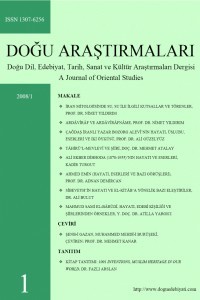THE CONCEPT OF “LOVE” ACCORDING TO RUMI AND SHAKESPEARE: A comparative study of Mathnawi and Antony and Cleopatra
Anahtar Kelimeler:
.
The main motif behind most of Shakespeare’s tragedies is the concept of Love. This concept may also be seen as the major theme in many of the stories of Rumi’s Mathnawi and Dīvân–e Shams. The fate of this love is usually the death of the lovers by the end of the story. This common theme, along with the common ending of such stories, is the main topic of this article. In this work, the definitions of love are briefly provided according to Sufism and Rumi’s ideas, and then 11 common items with respect to the concept of love are studied in the works of these two great literary figures. The data for this research have been collected based on Shakespeare’s tragedies, and Rumi’s verses, and the concept of love has been studied in two levels of Form and content. The idea of love forms the basis of Shakespeare’s tragedies, and leads to the death of the lovers. Therefore, death is also studied within this framework along with love. The ultimate goal of this article is to provide an analysis of the common features of love in Shakespeare’s work from the eye of an oriental, Persian-speaking reader, who is more acquainted with Rumi’s works. Among Shakespeare’s tragedies, Antony and Cleopatra has been chosen as the main source, however, the other great tragedies of his have not been neglected
Keywords:
Rumi, Shakespeare, love, Antony and Cleopatra Mathnaw,
___
- Baqâ’ī, M. (1386/1997). Ensân-e Kâmel az Nazar-e Molavī. Tehran: Ettelâ’ât.
- Dashtī, A. (1362/1983). Seyrī dar Dīvân-e Shams. Tehran: Jâvīdân.
- Dashti, Ali. (2003). A Voyage Through Dīvân-e-Shams: Celebrating Rumi, Translated from Persian By Sayeh Dashti. Tehran: Ketâb Sarâ.
- Fâtemī, H. (1364/1985). Tasvīrgarī dar Qazalīyyât-e Shams. Tehran: Amīr Kabīr.
- Fotuhī, M. (1385/2006). Balâqat-e Tasvīr. Tehran: Sokhan.
- Lings, Martin. (1998). The Sacred Art of Shakespeare: to take upon us the mystery of things. Vermont: Inner Traditions International.
- Purnâmdariyan, T. (1375/1996). Didâr bâ Sīmorq. Tehran: Pazhuheshgâh-e ‘Olum-e
- Ensânī va Motâle’ât-e Farhangī. Purnâmdariyan, T. (1380/2001). Dar Sâye-ye Âftâb. Tehran: Sokhan.
- Qazzâlī, M. (1361/1982). Kīmīyây-e Sa’âdat, edited by H. Khadīv. Tehran: ‘Elmī o Farhangī.
- Qazzâlī, A. (1358/1979). Majmu’e-ye Âsâr-e Fârsī, edited by Ahmad Jâhed. Tehran
- University of Tehran Press. Ritter, H. (1374/1995). Daryâ-ye Jân, translated by A. Zaryâb Kho’ī and M.
- Bâybordī. Tehran: Al-Hodâ. Rumi (Jalâl ol-Din Mohammad Balkhī) (1362/1983).
- Dīvân-e Shams, Edited byAli Dashtī. Tehran: Amīr Kabīr. Rumi (Jalâl ol-Din Mohammad Balkhi) (1381/2002). Mathnavī, Edited andtranslated by R. A. Nicholson. Tehran: So’âd.
- Rumi, Jalal alDin, (1949), The Rubaiyat of Jala Aldin Rumi, Selectedtranslations into
- English verse by: A. J. Arberry. London: Emery Walker. Shakespeare, W. (2004). Antony and Cleopatra. Pennsylvania State University Digital Library.
- Shakespeare, W. (2004). King Lear. Pennsylvania State University Digital Library.
- Shakespeare, W. (2004). Hamlet. Pennsylvania State University Digital Library.
- Shakespeare, W. (2004). Otello. Pennsylvania State University Digital Library.
- Schimmel, AnnMarie. (1377/1998). Man Bâdam o To Âtash, translated by F. Badre’ī.
- Tehran: Tus. Sorush, A. (1386/2007). “Qīyâmatgâh-e ‘Eshgh”. Shahrvand-e Emruz
- Tâjdīnī, A. (1383/2004). Farhang-e Namâd-hâ va Neshâne-hâ dar Andishe-ye
- Molânâ. Tehran: Sorush.
- ISSN: 1307-6256
- Yayın Aralığı: Yılda 2 Sayı
- Başlangıç: 2008
- Yayıncı: Ali GÜZELYÜZ
Sayıdaki Diğer Makaleler
THE SAFAVID AND NON SAFAVID PRETENDERS MAHNAZ SARPISHEGI
DİL MESELESİ Dr. IJAZ SHAFI GILANI, SYED MUTTAQEEN-UR-RAHMAN
FARSÇA LÜGATLER∗ SAİD-İ NEFİSİ
BROCKELMANN’IN ARAP DİLİ ve KÜLTÜRÜNE KATKILARI
ARDAVİRÂFNÂME VE İLAHİ KOMEDYA
